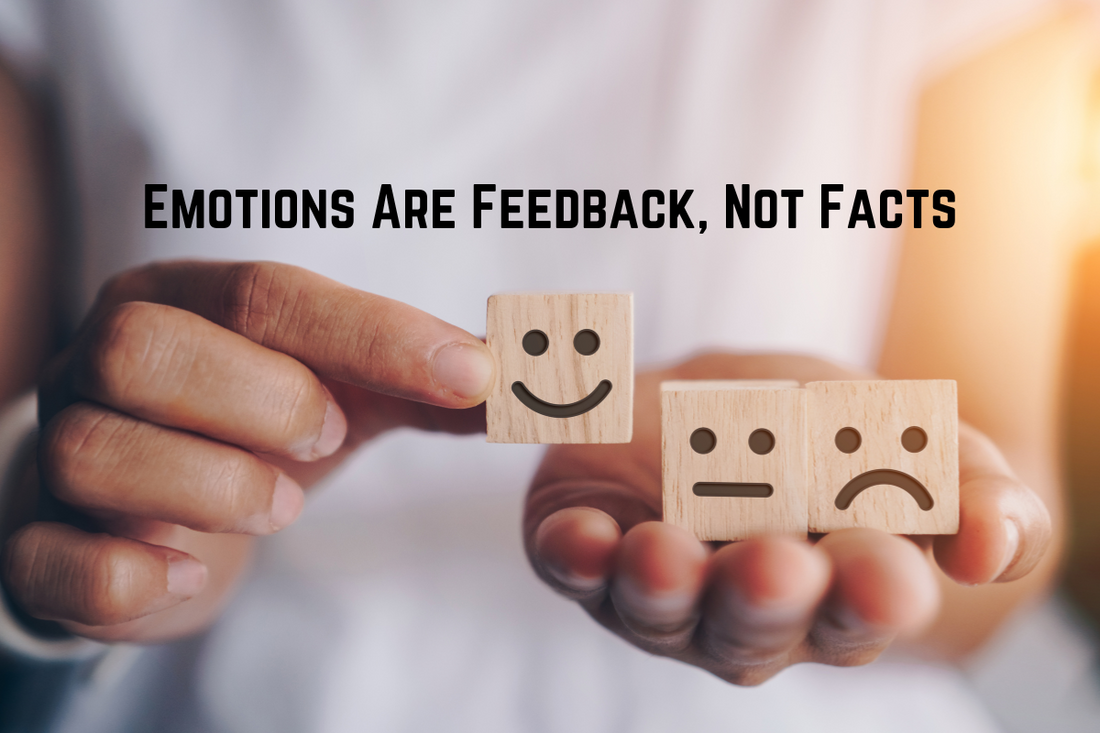
Emotions Are Feedback, Not Facts: Understanding Their Role in Your Growth
Share
Have you ever felt swept away by a strong emotion, only to later realize it didn’t align with the truth of the situation? Emotions, while powerful and real in the moment, are not the ultimate authority on reality. Instead, they are feedback—signals from your internal world offering insight into your perceptions, needs, and triggers. Understanding this distinction is a game-changer in navigating life with clarity and empowerment.
Emotions as Feedback
Emotions are like messengers, delivering information about how you are interpreting and responding to your experiences. They aren’t inherently “right” or “wrong,” but they always hold value in helping you understand yourself better.
- Feedback on Perceptions: Emotions often reflect how you’re perceiving a situation, whether those perceptions are accurate or influenced by past experiences.
- Feedback on Needs: Feelings such as sadness, frustration, or joy often highlight unmet needs or fulfilled desires.
- Feedback on Alignment: When emotions like peace and excitement arise, they may signal alignment with your values and goals. Conversely, unease might point to something requiring your attention or adjustment.
The key is to recognize that emotions are indicators, not absolute truths. They invite exploration, but they don’t dictate the full story.
The Trap of Treating Emotions as Facts
It’s easy to mistake emotions for facts, especially when they’re intense. For example:
- Feeling rejected after someone cancels plans might lead to the belief that they don’t care about you, even if the cancellation had nothing to do with you.
- Experiencing fear before a big decision can convince you it’s the wrong choice, when in reality, the fear may stem from stepping out of your comfort zone.
When you treat emotions as facts, you risk allowing temporary states to shape long-term beliefs or actions. This can lead to unnecessary conflict, self-doubt, or missed opportunities.
How to Use Emotions as a Guide
Instead of letting emotions define your reality, approach them as valuable feedback. Here’s how:
1. Pause and Acknowledge
When a strong emotion arises, pause. Name the feeling without judgment: “I’m feeling anxious,” or “I’m feeling hurt.” This simple act creates space between you and the emotion, allowing you to observe it rather than be consumed by it.
2. Ask What It’s Telling You
Explore what the emotion might be signaling:
- What perception or belief is this emotion tied to?
- Is there an unmet need I should address?
- Does this feeling align with my current reality, or is it tied to a past experience?
3. Separate Feeling from Fact
Distinguish between what you feel and what you know to be true. For instance:
- Feeling: “I’m scared to speak up.”
- Fact: “I have the ability to express myself, even if it feels uncomfortable.”
This separation empowers you to respond thoughtfully rather than react impulsively.
4. Respond with Intention
Once you’ve gleaned insight from the emotion, decide how to respond. For example:
- If the emotion highlights an unmet need, take action to address it.
- If it’s tied to a past wound, practice self-compassion and remind yourself of the present reality.
- If it signals alignment, celebrate and lean into the experience.
The Power of Viewing Emotions as Feedback
When you embrace emotions as feedback, you:
- Gain Clarity: You’re able to differentiate between internal triggers and external realities.
- Cultivate Resilience: You learn to navigate emotional waves without being overwhelmed by them.
- Foster Growth: Emotions become a tool for self-awareness and personal development.
Practical Exercises to Deepen This Practice
The 3-Step Emotional Check-In
- Pause: Take three deep breaths to ground yourself.
- Name the Emotion: Identify what you’re feeling without judgment.
- Explore the Message: Ask, “What is this feeling trying to tell me?”
Journaling Prompt
Reflect on a recent emotional experience. Write about:
- What you felt.
- What you initially believed because of that emotion.
- What you discovered upon reflection.
Affirmation Practice
Use affirmations to reinforce the idea that emotions are guides, not dictators. For example:
- “I honor my emotions as valuable feedback.”
- “I choose to respond to my feelings with curiosity and compassion.”
Closing Thoughts
Understanding that emotions are feedback, not facts, liberates you from being ruled by temporary states. It empowers you to engage with your inner world thoughtfully and intentionally, fostering clarity, growth, and peace. The next time you’re swept up in a strong feeling, pause and remind yourself: “This is feedback, not the full story.” You might be amazed at the wisdom that unfolds.
~ Crystallynne 🌟
